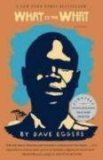 I had the pleasure of interviewing artist Gaye Chan earlier this year, but due to space restrictions in the Advertiser couldn’t print her full interview, so it’s available below for the first time. If you have time, check out her work with Downwind Productions, one result of which is the groundbreaking book Waikiki, which I reviewed in early 2007 and often pull from my shelves to peruse anew.
I had the pleasure of interviewing artist Gaye Chan earlier this year, but due to space restrictions in the Advertiser couldn’t print her full interview, so it’s available below for the first time. If you have time, check out her work with Downwind Productions, one result of which is the groundbreaking book Waikiki, which I reviewed in early 2007 and often pull from my shelves to peruse anew.
What I’m Reading | Gaye Chan
Prof. of Photography and Art, UH Manoa
Art Director, Tinfish PressQ&A with Christine Thomas
March 2008I am reading “What Is the What” the Autobiography of Valentino Achek Deng, a novel by David Eggers. I am about 3/8″ through a 1 1/8″ thick book. It is based on Eggers’ interview of Valentino Achek Deng. Deng was one of what the relief workers calls THE LOST BOYS OF SUDAN, one among the tens of thousands of children in Sudan who was displaced by ‘civil’ war. The book begins in Atlanta (US), when Deng relocated, and in the middle of being robbed. The robbers struck, bound and gagged him and left him bleeding on his living room floor with a boy about Deng’s age when he was a refugee. So far, much of the book is stories Deng tells himself in his head, or imagines telling others if he wasn’t gagged – literally or metaphorically. The stories are of his life in Sudan.
-How did you discover this book?
A few months ago I received an email from an old flame from graduate school. We parted with some tension but she found me via the internet. We have been ‘catching up’. She told me of many things including having just finished reading this amazing book, “What Is the What“. I was curious.
-What do you like most about it?
I don’t know if I like the book, yet. I do like novels inspired by history that deploy unlikely central characters, offering a different and unexpected vantage point into it. Another book I just finished of this genre is “The Book of Salt” by Monique Troung set in Paris in the 1930s seen through the eyes of Gertrude and Alice’s cook—a gay man who escaped Saigon.In “What Is the What” there are a couple of great exchanges between the character Deng, bound and gagged on the floor, and the boy who the robbers left with him. Deng calls him TV Boy because he watches TV endlessly. Deng attempts to get TV Boy’s attention and empathy. Uninterested, TV Boy tries to end this disruption by dropping a telephone book on Deng’s head. Presumably to kill him with it. I like the juxtaposition of these different kind of violence – the most horrific and the most banal, the most definitive and the most ineffectual – all equally unfathomable.
-Do you gravitate to unexpected points of view when reading because in your art you also try to bring to life and legitimize people’s experiences that aren’t usually included in ‘official’ accounts of history?
I certainly am drawn to art and writing that are watchful of and expose how hegemony is made. But simply placing an “Other” in the center is not enough. I hate villain / hero / victim stories for their dumb propaganda.

